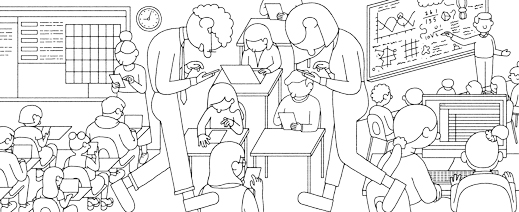The Connected Classroom
Digital Documents
New apps and software platforms allow teachers to keep their student lists, attendance records, calendars, and correspondence all in one place. Google Classroom is one that allows students to hand in homework online and see their grade when the teacher is done reviewing it. Schoology is another popular example.

Communication
More than 20 percent of U.S. teachers use an app called Remind to text parents and students about deadlines without exposing personal information, according to the app maker. Pearson’s PowerTeacher and PowerSchool apps give parents real-time feedback about their children’s grades or behavior.
Class Websites
Teachers can make class websites using Haiku Learning or Google Sites without writing code. Many schools now make announcements on Facebook and Twitter. Science teacher Jessica Anderson at Powell County High School in Deer Lodge, Montana, uses the @SciencePCHS tag on Instagram, Twitter and Vine to post class projects like a Rube Goldberg machine.
Gaming
Students can earn points for good behavior on ClassDojo, or by answering questions on their smartphones in the Kahoot! app, which claims 30 million users. Students playing ClassCraft use special powers to advance their team through a virtual world. Correct answers unlock perks like asking questions during tests.
Student Devices
More and more schools aim to have a laptop or tablet for every student. The 435 students at Intrinsic, a charter school in Chicago, had Chromebooks last year. Powell County High School distributed laptops to students three years ago, switched to iPads this year and will issue HP Stream laptops next year.
Projects
Students can map out writing assignments on iPads through Inspiration and upload notes into Google Drive with Notability. Writing.com’s Writing Promps app gives students ideas for essays, and Scholastic’s Book Wizard helps students and teachers keep track of interesting books they would like to read.
Classrooms Design
Intrinsic divides its English and math classrooms into different areas. Students learn directly from teachers in one section, have group discussions on blue chairs in an area called the “ocean,” work independently on the “coastline” (which snakes around the room’s perimeter), and work in groups at tables in the “shade.”
Streamlined Security
Protecting and securing student data is a growing concern. Through Clever, teachers decide which education tools can access encrypted student data and how much they can see. Clever, Apple, Google and AT&T are a few of the 150 technology companies pledging to protect student data from being sold or used for advertising.
Keep Reading
Most Popular
Large language models can do jaw-dropping things. But nobody knows exactly why.
And that's a problem. Figuring it out is one of the biggest scientific puzzles of our time and a crucial step towards controlling more powerful future models.
The problem with plug-in hybrids? Their drivers.
Plug-in hybrids are often sold as a transition to EVs, but new data from Europe shows we’re still underestimating the emissions they produce.
Google DeepMind’s new generative model makes Super Mario–like games from scratch
Genie learns how to control games by watching hours and hours of video. It could help train next-gen robots too.
How scientists traced a mysterious covid case back to six toilets
When wastewater surveillance turns into a hunt for a single infected individual, the ethics get tricky.
Stay connected
Get the latest updates from
MIT Technology Review
Discover special offers, top stories, upcoming events, and more.